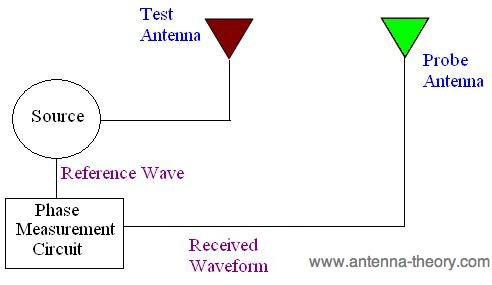Measuring Phase
|
For an antenna's radiation pattern to be completely specified, we need the magnitude of the power received or transmitted,
AND the phase. These measurements should be specified in two orthogonal directions in order to capture all the components (polarizations)
of the antenna. For instance, suppose an antenna transmits at frequency f and the fields travelling in the +y direction at a particular point are seen to be:
 The E-fields are orthogonal to the direction of travel in the far field region. The magnitude of the x-component of the E-field is A and the magnitude of the z-component of the E-field is B. The phase of the x-component is D and the phase of the z-component is F (relative to the oscillation at frequency f). If D=F, the components are in phase and the polarization is linear. If D and F are separated by pi/2 radians (90 degrees) and the amplitudes are equal, the E-field is circularly polarized. The phase is a relative quantity - that is, it must be measured relative to some fixed reference. On this page, we will discuss determining the phase of the fields radiated from an antenna. The easiest way to measure phase is the method shown in Figure 1. In this method the test antenna is used as the source antenna, and another antenna is used to receive the fields. For this method to work, the observation point is not too far from the test antenna, so that the source waveform feeding the test antenna can also be run into a phase measurement box. This box compares the locations of the peaks and valleys of the received signals and determines the relative phase from this information. The receive antenna is moved and then the process is repeated.  Figure 1. Measuring the Phase of a Test Antenna When the Observation is 'Near' the source. If the test antennas are very far from each other and the reference (source) waveform can not be fed directly into the phase measurement circuit (this happens at low frequencies and large outdoor ranges where many wavelengths becomes a large distance), then a standard antenna with known phase characteristics is used to transmit a wave, which is used to compare with the received signal from the test antenna. In the next section, we will look at measuring an antenna's polarization.
|